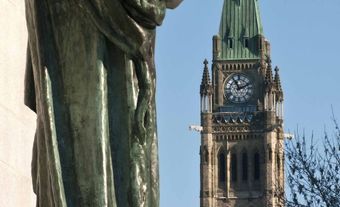Local Government
Local government is the level of government below the provinces. The most important local governments are the MUNICIPAL GOVERNMENTS. Under the constitution, the provinces have exclusive jurisdiction over municipal affairs (see MUNICIPAL-PROVINCIAL RELATIONS). Each province has established a slightly different system of municipal institutions, but there is a strong family resemblance among these systems, because they are all derived from British or American models.
Canada's first uniform municipal system was established in 1849 in what was then Canada West [Ontario]. The other provinces followed the Ontario example, and most of the populated area of Canada is now organized into municipalities, although there are great tracts of sparsely populated land that remain unincorporated for municipal purposes. In the latter areas, local administration falls to the PROVINCIAL GOVERNMENT or the territorial government, although in some places quasi-municipal institutions, such as improvement districts, have been formed.
A local government is distinguished from a local administrative office of the province in that it is chosen by and held accountable to the local community, conventionally by means of aLOCAL ELECTION. Other local administrative bodies may also be elected. This is generally true not only for SCHOOL BOARDS, but may also be true for public utilities commissions, parks boards and other special-purpose agencies. The municipal council is therefore not the only elective local government in most Canadian communities. There is a further complication in that many other more or less autonomous local agencies - harbour commissions, library boards and police commissions - have been established by the provincial or federal governments or by the municipalities themselves. However they are constituted, these agencies often operate like independent local governments.
In no Canadian community is the situation quite similar to that in metropolitan Chicago, where more than 1000 special-purpose and general-purpose local governments are at work, but the system of local government is everywhere complex and is unique to the community concerned. The bigger the community, the more complex the system: in metropolitan TORONTO, for example, researchers have identified more than 100 authorities that could be classified as "local governments."
Despite these complexities, the municipalities remain the most important elements in systems of local government. In most places, the municipalities are the only general-purpose governments at the local level and the municipal council is therefore usually the focus of attention in local politics. The council is expected to concern itself with matters of general interest to the community and to represent the community in its relations with the outside world. The powers granted to the municipalities under the Municipal Acts of the various provinces reflect this, for municipal councils are the repositories for local government functions not assigned to other agencies. The multiplication of special-purpose bodies at the local level itself is testimony to the role of the municipalities, since these bodies have been formed to relieve the general-purpose governments of the ostensibly specialized functions that they are ill equipped, as general governments, to perform.
In each province, there are different classes of municipalities. The most important distinction is between urban and rural authorities. The latter - called TOWNSHIPS, parishes, districts, rural municipalities, etc - have the most limited functions. Generally, their most important duty is to maintain roads. People in rural areas have rarely been willing to pay for very active local government.
On the other hand, in urban areas where there is a need and demand for more government activity, the situation is different. Urban municipalities are classifed by size as villages, towns and cities; to be reclassified upwards means an increase in prestige and in the powers of the municipal council. City councils are the most active municipal governments and have played a major role historically in developing new public services and the regulations necessary to modern life.
The relative increase in the activities of the provincial governments since 1945 is partly the result of an effort to make city-quality services available elsewhere. In the course of this effort, functions once performed at the municipal level (if they were performed at all) have been taken over by the provincial governments. This applies particularly to social services. What remains at the core of municipal activity is a set of economic functions.
Municipal councils have always been expected to serve as agencies for local economic development. Most of them regard it as their first responsibility to provide the infrastructure for the local economy, eg, physical facilities such as roads and sewers, and basic services such as POLICE and fire protection. Since 1945, the urban municipalities in particular have attempted to play a more positive role by using physical planning controls to set the pace and determine the form of economic development. Planning issues have thus become central to municipal politics.
Municipal councils and other elective local authorities in Canada are generally quite small. Most comprise from 5 to 15 members; only the largest municipalities are liable to have bigger councils. It is usually feasible for the council (or school board) to act as its own Cabinet, with the mayor (or chairman) taking the leading role. Because most councillors are theoretically nonpartisan, collegial decision making is possible. Most councils divide themselves into committees for the different municipal functions, and this eases the burden on the central body. The traditional tendency to delegate duties to semi-autonomous agencies (whose boards are largely appointed by the municipal councils) further reduces the scope of responsibility at the centre.
Since the beginning of this century, critics have been pointing to the problems arising from this dispersal of municipal responsibilities and from the connected emphasis on lay participation in administration. As a result, there have been constant efforts to make local government more professional and to centralize managerial control. In some municipalities, full administrative responsibility is given to a single manager or administrative board, acting under the political direction of the council. Elsewhere - especially in large communities - the function of executive control has been taken over by a committee of the council. In either case, ordinary councillors have become more removed from day-to-day business and stronger managerial control has been established.
Municipal governments must generally depend on real property taxes for most of their own revenues. This limits their financial capacity, and forces them to rely on provincial grants, which limit municipal discretion. Indeed, the municipalities and other local governments have been used increasingly as mere administrative agencies of the province and have been subjected as such to tight controls.
Even when local governments are acting independently, using their own revenues for their own purposes, they are subject to the laws and regulations of the province. These may severely restrict local freedom of action, and force the governments concerned to seek provincial approval for capital spending, land-use regulations and other items of local concern. The provincial department of municipal affairs is normally the most prominent agency of control, but other departments and administrative tribunals (eg, the Ontario Municipal Board) are also involved. Local governments simply do not have the autonomy in relation to the provinces that the latter enjoy in relation to Ottawa.
Many critics have claimed that local government could be strengthened by consolidating existing authorities into larger units with wider responsibilities. This would mean eliminating most, if not all, of the special-purpose local governments and redrawing municipal boundaries to bring suburbs and satellite towns under the control of city councils. In rural areas, whole regions or counties might be unified. However, the provinces have little incentive to create local governments that would rival them in power and prestige. Thus, the trend throughout Canada has been to make comparatively minor adjustments in boundaries and functions, and to preserve local government arrangements in the face of socioeconomic change.
The most obvious recent development has been the double-tiering of municipal government. The COUNTY councils of central Canada have traditionally provided a second-level of municipal government outside the cities. These councils are composed of representatives of neighbouring rural and small urban municipalities and exist to provide common facilities and services. This model for joint action was not adopted in major urban areas until 1953, when the municipality of Metropolitan Toronto was established. The new authority was in effect a metropolitan county council for Toronto and its suburbs. To deal with problems of metropolitan development and planning, it was given greater powers than any ordinary county, and it was successful enough to inspire many imitators in Canada and elsewhere.
Most of the major cities in Canada now have metropolitan or regional governments of this sort. The model has also been applied outside the metropolitan areas to strengthen or replace existing county government (as in Ontario) or to create a new level of regional municipal government (as in BC).
The creation of new units of regional municipal government reflects a more general tendency in the past few decades to enlarge the scale of local administration. Health, education and welfare administration - traditionally entrusted to special-purpose local authorities - has generally been regionalized, if not provincialized. Thus the independent local authorities that remain in these fields tend to be on a larger scale. The municipalities have been less affected by consolidation than have the school boards; generally they have maintained their existence even when over-arching REGIONAL GOVERNMENTS have been established.
While consolidation becomes an increasingly frequent occurrence, there are still some 5000 municipal governments in Canada, and new ones continue to be formed. It is difficult for provincial governments to persuade local communities to take responsibility for their own affairs without organizing municipal councils. Once created, these councils become symbols of local autonomy and are not easily eliminated.
To those concerned about comprehensive planning and administrative co-ordination, the fragmentation of authority at the local level among thousands of municipalities and even more numerous special-purpose bodies is the source of much anxiety. However, it is not clear that consolidation would increase the efficiency or effectiveness of local government, because bureaucratic centralization creates its own problems.
Whatever advantage there is in the present system arises from the opportunities it affords for local initiative and citizen participation. To simplify present arrangements and consolidate authority in the hands of strong regional councils would be to close off many of these opportunities. This may occur regardless, but so long as the demand remains for effective local control over local public activities, the system of government at this level will remain as complex as it is now.

 Share on Facebook
Share on Facebook Share on X
Share on X Share by Email
Share by Email Share on Google Classroom
Share on Google Classroom


